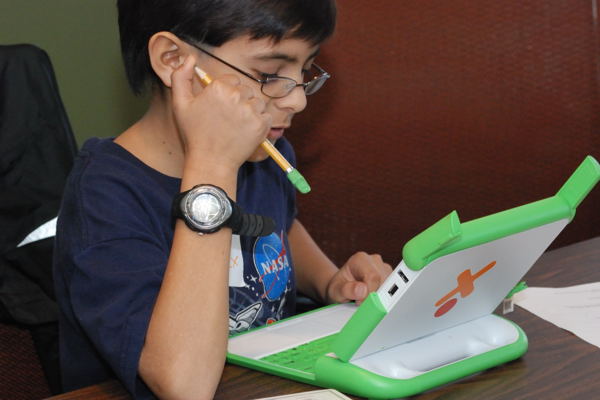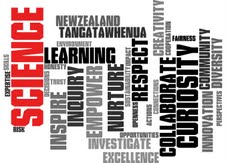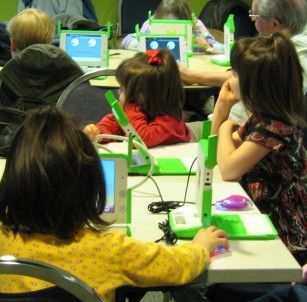I was somewhat aware of copyright on published books and articles because of the college teaching job. As a teacher, I often reprint and distribute handouts, articles, and other materials published…
Source: COPYRIGHT LAW IN US
I was somewhat aware of copyright on published books and articles because of the college teaching job. As a teacher, I often reprint and distribute handouts, articles, and other materials published…
Source: COPYRIGHT LAW IN US
Social media and its use by children and teens have been a controversial topic to say the least. GuardChild.com reports over 80% of adolescents have at least one profile on social media. A reason…
Cloudware technology such as Flickr, Picasa, and Google Docs provides a unique opportunity for collaboration in the educational environment. When I began to use Google Documents, I was pleasantly surprised on how easy it was to navigate this app. This app looked a lot like a Word Document but simpler and much more user-friendly. Moreover, I notice the popularity of Google Doc among my colleagues and high school students alike. Just recently I taught my students how to save the research information including the text and pictures in the Google doc when they were preparing the Biome Project presentation. The fact that all Google applications are automatically saved in the cloud such as Google Drive prevents the loss of any materials, thereby increasing the security and accessibility of any document or a presentation. For example, I graded students’ research as prep work for the final project by looking at the Google Document they created with their partners. No documents was ever lost or misplaced, and students could no longer use the excuses to cover up their flop.
In addition, Cloudware delivers the marvelous opportunity to collaborate, create, and problem-solve a variety of challenges. The application may be immediately updated by the people who are participating in the group project, professional development, or other type of collaboration. The process of immediate feedback, live updates, and active contribution enables us to interact and publish with peers, communicate information and ideas effectively to multiple audiences using a variety of media and formats. All of these important skills prepare students for the real-world jobs and environment where problem-solving, critical thinking, and strategic planning are valued more than ever.
For more information on Cloud ware technology Check out the video below:
“Mitra argues that the information revolution has enabled a style of learning that wasn’t possible before.” — Wired
Sugata Mitra’s videos pose the question of what the process of learning was in the past, present, and how it may change in the near future. I thoroughly enjoyed the story of Victorian educational system and how it influenced schools around the globe. The paramount notion and message that Mitra delivers to us is that children are able to teach themselves the material that they are genuinely interested in regardless of how difficult it may appear. Such examples in his experiments include children who learned English, basic computer hardware and software installation, even Molecular Biology topics. Mitra designed, conducted, and repeatedly proved the experiment of children who are left to use a computer freely for nine months can become as proficient as a secretary in US. Acquisition of computer literacy, proper English language pronunciation may seem like difficult tasks, but children in the poorest cities of India have mastered these skills without any directions from the teacher.
I see this new type of leaning played out every day in the classroom. Children no longer interested in reading the textbook, or writing the notes. They want to learn by doing a hands on experiment, they wish to create a poster, draw a picture, make a powerpoint presentation rather than sit through a boring lecture. The learning in the new age of technology does not require for the teacher to “give” knowledge to children. Rather students must learn how to create, problem solve, and collaborate with their peers and acquire the important skills thy will need in the future.
Mitra’s experiments have tremendously impacted me as a future science teacher. I hope to become an efficient educator, and this means I would have to step away from the ‘old’ model of education and utilize technology and Project-Based learning to deliver science lessons that are engaging and relevant.

Learning by doing at the SeaXO meeting
Photo By Dennis Hamilton (Flickr: Future Astronaut) licensed under CC BY 2.0 via Wikimedia Commons
When I think of Project-Based Learning I envision a classroom filled with students whose curiosity and thirst for discovery drive the learning experience. But this image is not nearly close to what I have experienced as a student. I learned in a school where teachers were the ‘masters’ or the knowledge who went through a routine of delivering the material, a practice, and finally the test. The content may have changed depending on the class, but the format remained the same.
Project Based learning is conceptually and practically different from the traditional pedagogic methods. We’ve got a glimpse of how far students may reach with the freedom of exploration from Sugata Mitra’s research “A Hole in the Wall”. Project-Based learning is currently favored by many school districts, and eagerly implemented by teachers grades K through twelve. We as teachers in training must carry the torch of PBL into our classrooms as well.

Project-Based Learning (PBL) is dramatically different from what I have experienced as a student. Nowadays, technology functions as the tool rather than as the focus of learning, and allows for collaboration and communication on many levels. PBL form the centerpiece of instruction as “academically rigorous projects that immerse students in real-world learning” (Boss & Krauss, Ch.1). As we have learned from the book, PBL shifts teacher’s role as well as students’ behavior. The teacher is no longer a ‘know-it-all’ guru, rather s/he actively facilitates the learning inquiry by helping students develop critical thinking and problem-solving skills. In their turn, students improve their communication skills, learn to work in a team, practice leadership skills while acquiring core curriculum knowledge. The advantages of PBL is students’ greater depth of understanding concepts, broader knowledge base, and increased creativity. The problem that student faces when using technology-based assignment is staying focused on specific activity, sorting through an enormous information portal, and using computer for educational purposes rather than a tool for communication or entertainment. Teachers may opt for PBL in their classrooms to actively engage students in learning cutting-edge technology and current cultural events by nurturing their independent reasoning and analytical skills. After all, we live in a time when technological advances reach far beyond what we could ever imagine.
Review this video from PLTW website:
Image “Science vision” by Jriddell, CC BY-SA 3.0 via Wikimedia Commons
With many technological advances teachers integrate the use of the laptops and iPads on a weekly basis. There are plenty of engaging applications and websites to explore, such as Kahoot, Edmodo, and ExploreLearning. However, a teacher must be aware of potential technology flop that may turn even the most amazing lesson into fifty five minutes of pure frustration. This was the case for Ms. El, a first-year Biology teacher at Triumph Charter High School (TCHS) in Sylmar, CA.
Classroom Management
Using laptops in the classroom has many advantages, but the teacher has to deliver explicit rules and develop an efficient routine to ensure the seamless integration of technology. Ms. El chose to assign the laptop numbers according to the class roster. In the beginning of the lesson, she takes attendance while calling students to get their assigned computer. This strategy limits the traffic congestion around the laptop cart ensuring students’ safety and accountability for the computer while it is in use.
Safety Concerns
School’s files contain detailed files that include sensitive information of students’ demographics, medical history, family, and academic reports. Media has reported many unlawful Internet incidents involving minors. Companies such as Microsoft developed a protocol of response to IT security bridges. Understandably, IT security must be delivered and maintained at all school campuses. For instance, Wi-Fi signal on the campus of Triumph Charter High school is interrupted and prevents students from accessing social media websites such as Snapchat, Facebook, or Twitter.
Backup or not to backup
In Triumph high school the budget is limited. Therefore, the new Biology teacher found planning, supplying, and executing an experiment not feasible. Imagine Ms. El’s joy and excitement when she found the Food Chain Gizmo on ExploreLearning.com. The website demonstrates the interdependency of populations, and allows students to manipulate the population numbers to practice the crosscutting scientific concept of cause and effect. This simulation gave students the opportunity to learn Ecology ideas without leaving their classroom. During the first two periods students successfully completed the activity, filled in the notes, and were quite engaged in the learning process. Class took a dramatic turn when 4th period students were unable to login to the website. The same username and password previously used by fifty students was repeatedly rejected. Kids were disappointed and lost their interest. Ms. El was standing in the middle of the class not sure how to handle this disaster. She called a colleague for help, but the class time was forever lost.
A great teacher always learns from her mistakes. The bottom line is teachers should always have a backup lesson plan in case the technology fails. Having a plan B can reduce the stress of dealing with unforeseen circumstances, unmotivated students, and mitigate the loss of valuable class time. For more ideas on well-developed lessons go to BetterLesson.

Photo: A class with one laptop per child by By Mike Lee licensed under CC BY 2.5
In the long run, we shape our lives, and we shape ourselves. The process never ends until we die. And the choices we make are ultimately our own responsibility. Eleanor Roosevelt
Source: About
“The more I learn, the more I realize how much I don’t know,” was once said by one of the greatest scientist Albert Einstein. I do not wish to sound pretentious, but this is exactly how I feel as I am sprinting toward the final project of Education 407 – Learning Technology for Educators. The very first assignment in the class has set the tone for what was in store for me. When I created my very first post on WordPress I began to realize that learning is truly a life-long process. Before this class I considered myself quite proficient in computer and software skills. However, the number of capabilities that I have acquired in just four short weeks appears quite staggering in the context of my computer literate existence.
I have done extensive research, evaluation, analysis, and exploration of various apps, educational projects, learning communities, and teaching strategies. I personally explored a new social network platform designed specifically for schools – Edmodo, and created a screencast to educate other teachers on its features and content (check out this post). I learned how to create content, embed videos, and attribute media using creative commons. I also created my very first E-Portfolio containing comprehensive record of my academic and professional career – see Proeled.
Finally, my quest for learning project-based pedagogy revealed a plethora of resources that I will sure use in my career as the educator using technology as a tool. Microsoft, TeacherTube, & Buck Institute for Education contain an extensive library of projects that facilitate effective and enjoyable learning process, help students develop deeper understanding of various concepts, and cultivate competencies required for success in college, career, and civic life.
Enjoy this YouTube video “Why is Technology Important in Education?”
“Any teacher that can be replaced by a computer deserves to be.” – David Thornburg
Source: Long-term, interdisciplinary and student-centered Project-Based Learning (PBL)
Who is the student interested in taking Psychology course at the local Community College? Well, I would know because I was one of them not so long ago. I studied and mastered the knowledge of psychology field since 1997 while attending Moldova State Pedagogic University majoring in Developmental Psychology. Interestingly, the course work covered at the foreign university included Neuroanatomy, Developmental and Abnormal Psychology, Methods of Teaching, etc. This curriculum cultivated relentless interest in Psychology as not only the study of human psyche, but as the philosophical standpoint that encourages tolerance and acceptance while abandoning judgment and application of stereotypes. At that time, learning about works of Jung, Skinner, Freud, Bandura, and Pavlov opened a new door to understanding human behavior, motivation, emotion, and mental disorders. In my freshman year, I remember presenting the synopsis of the book by Lev Vygotsky on Socio-Cultural theory of child development to fellow classmates. I felt empowered and vested with unique opportunity to share my knowledge and perspective on the material that I rigorously mastered anticipating teacher’s question. That one hour in front of my fellow students gave me the inspiration and strength to follow the teaching career despite the turns my life would take in the subsequent years.
The next chapter of my academic journey began at Santa Monica Community College where I declared Chemistry major with intention to become a medical professional. Academic load included Biology with lab, Inorganic and Organic Chemistry, Calculus and Calculus-based Physics. These classes developed the new regimen of learning which was based on the factual data and statistical analysis. Moreover, these coursework taught the significance of the research and experimental data while nurturing the investigative skills of the promising scholar. Eventually, the preparation and hard work paid off when I received the acceptance letter from the University of California, Los Angeles granting the admission to Psychobiology major in 2004. This program was fascinating, challenging, and exciting. Upon my graduation in 2007, I decided to pursue the graduate studies in Psychology by applying to Argosy University Orange County campus, and majoring in Counseling Psychology/Marriage and Family Therapy Program. Next couple years provided valuable experiences in terms of leaning various psychological theories and modalities, as well as their application in the treatment of mental disorders. We studied and analyzed Depression, Schizophrenia, Bipolar Disorder, Addiction, Autistic Spectrum of Disorders, ADD/ADHD, Obsessive Compulsive, and Dissociative Personality Disorder to name a few. The graduate program led to the internship at Ocean View School District in Huntington Beach where I worked as the counselor with students experiencing various academic, behavioral, and emotional adversities. These experiences were valuable in shaping my interpersonal skills when working with teachers and students, teaching the importance record -keeping, evaluation of students’ progress, and outlining the standards of professional conduct and ethics. At this point of my professional career I realized that I would ultimately aspire to work as the educator/mentor. The prospect of spreading the knowledge, and passing the torch of academic excellence to a younger generation provided unparalleled fulfilment and elation.
Moreover, the opportunity to teach Psychology course appeared when I received a call from Jeff Courchaine, the Dean of Social Sciences Division at Goldenwest Community College who offered a part-time faculty position in fall 2012. Initially, I taught a hybrid Psychobiology course (PsychologyG250) which included the application of Learning Management System (Blackboard), and a weekly lecture on campus. I effectively utilized Blackboard as the leading method of administering quizzes, publishing the class announcements, initiating the discussion threads, and submitting the research papers. Throughout my teaching experience I have discovered the importance of applying a teaching style that is relevant, engaging, and occasionally entertaining. Students enjoyed sharing their personal experiences while learning about the mechanism of behavior, the anatomy of the brain, physiological principles related to emotion, learning, and memory. I realized that encouraging students’ participation is one of the key factors necessary to sustain their interest. And there are many different pathways to accomplish this goal. During the lecture, I incorporate various learning modalities such as group activity, review of previous material via verbal or visual cues, preparation of the flash cards pertaining to novel terms and new concepts, viewing of innovative videos and animations relevant to the covered lecture. Also, I actively employ the Blackboard On-line Learning Management System to initiate the discussion among students, submit writing assignments, administer quizzes, and tests, as well as accurately collect students’ scores. In the course of my teaching career, I have developed numerous techniques to improve, evaluate, and report Student Learning Outcome (SLO).
Modern students are curious, ambitious, well-versed in current cultural events, addicted to social media, and dependent on the Internet. They appreciate the opportunity to learn about latest research in neuroscience, physiology, and psychology while applying the new information to real-world scenarios. To stay abreast of new experimental data I subscribe to professional magazines such as Scientific American Mind. Moreover, I attend various webinars related to my field of study such as Evidence-Based Nutritional Strategies for the Aging Brain, How Nutrients Affect Mental Health and the Brain, and Understanding and Treating Anxiety Disorders (provided by the Institute for Brain Potential). Another great opportunity to advance my teaching methods came from the Cengage Learning, a publishing organization that incorporates e-books and on-line learning seminars to help me, as the educator, keep track of students’ engagement in hybrid classes, customize students’ learning experience, and improve their study skills. In a nutshell, learning is a life-long process. In my opinion, it is the commitment to staying innovative, thought-provoking, and inspiring for the young generation to pursue their professional and academic goals while they acquire higher education as well as grow personally.
You must be logged in to post a comment.